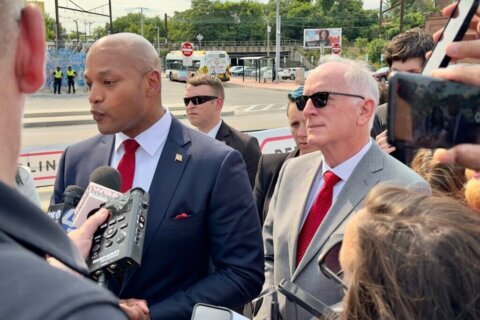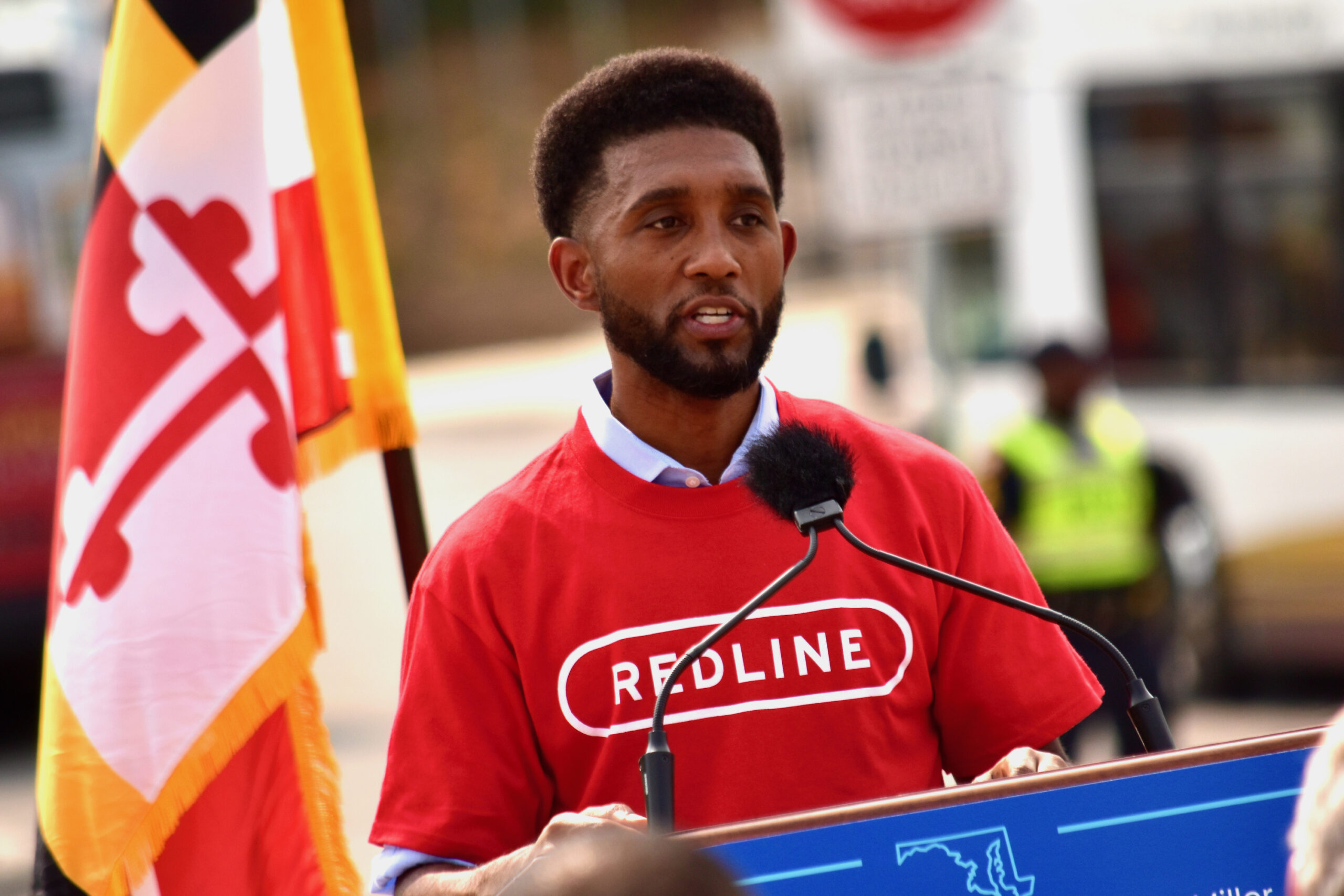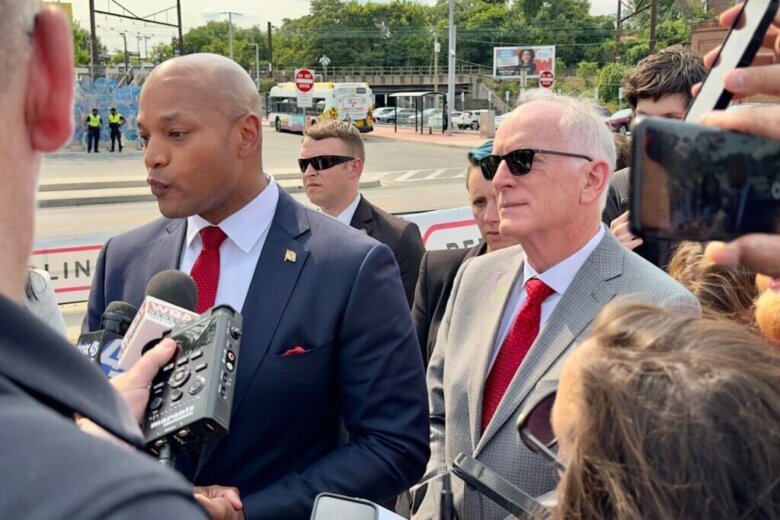
This content was republished with permission from WTOP’s news partners at Maryland Matters. Sign up for Maryland Matters’ free email subscription today.
State, federal and local officials led by Gov. Wes Moore (D) vowed Thursday to build a Baltimore transit system canceled by the Hogan administration nearly eight years ago.
Moore, during an hour-long press conference on a sweltering West Baltimore parking lot, vowed to move quickly to complete a new east-west line.
“I know we’re going to move at the pace and with the urgency that this moment does require,” Moore told reporters after the announcement. “We think that if we can put everything in place that will be able to begin our construction within 2026, 2027. We’re going to move as fast as humanly possible to be able to complete this.”
“…We’re going to get this project done,” said Moore. “We don’t start things with no intention of finishing. We finish things. We’re going to get this done.”
Former Gov. Larry Hogan (R) canceled the original Red Line project in 2015.
The plan was to connect Bayview Hospital in east Baltimore with Woodlawn in western Baltimore County over a 14.1-mile light rail line.
Hogan entered office having to decide the fate of the Baltimore project and the Purple Line light rail project.
The governor approved the suburban D.C. line connecting Prince George’s and Montgomery Counties.

He declared the Baltimore project “a boondoggle” and canceled it. The decision meant forgoing $900 million federal aid earmarked for the Red Line.
The decision left many city leaders disappointed and angry. Those feelings linger eight years later.
Mayor Brandon Scott (D), speaking of Hogan’s cancellation of the Red Line, did not mention Hogan by name but compared him to Voldemort, the villain in the Harry Potter book and movie series.
“We all know that when the decision was made to cancel this billion-dollar transit expansion for our community, it was a deliberate and catastrophic disinvestment into our city,” said Scott. “It was a massive loss for the entire region. But He-who-shall-not-be-named knew it would be particularly devastating to Baltimore City.”
The 16-mile Purple Line light rail project, which was mired with its own turbulent history including court battles and cost overruns, remains under construction, with service expected to begin in 2026.
“There are a lot of lessons on the Purple Line,” said Transportation Secretary Paul Wiedefeld. “You got to make sure you know what you’ve got and that the budget and schedule is solid before you start a project and then continue to hit on it. And to be frank, that’s one that has not been scaled to begin with.”
Moore’s announcement represents an initial step toward fulfilling a campaign promise. The relaunch leaves years of studies, planning and efforts to secure funding before breaking ground. A rideable transit line is farther away still.
The lack of details did little to deter the excitement of Del. Robbyn Lewis (D-Baltimore).
“What I do know is that our governor is committed to building an east-west rail line to restore what was stolen from our city and region,” said Lewis. “That, for me, is reason enough to show up. I don’t need to know all the details right now. Just knowing that we have an executive leader at the top of our state government who’s committed not just to modernizing transit, but to activating our economy and creating jobs for the people of Baltimore City and our region, I’ll out in the hot asphalt parking lot all day for that.”
One of those studies will effectively strip the plan for the original Red Line project for usable parts. Transportation officials will build on those parts and update portions affected by nearly a decade of change.
Moore described the status of the project as an “examination phase.”
An initial phase will identify possible routes and transportation modes. Public feedback from that initial stage will be used to refine alternatives later this summer. Officials hope to have a detailed study including costs, benefits and impacts.
By early 2024, state transportation officials will identify potential options that could advance to federal environmental studies, and seek federal dollars for the project.
“We’re not all the way at the beginning,” said Maryland Transit Administration Administrator Holly Arnold. “We’re definitely not starting from scratch. We have 10 years’ worth of work that we’re able to use in this project.”
But Arnold hedged on exactly when the state expects to break ground on the project.
“It’s really going to depend on what mode we choose and if we choose a tunnel or not,” said Arnold. “I mean, like absolute best case, potentially 2027. But you know, I think we need the stars to align to make that happen.”
Celeste Chavis, a professor of transportation and urban infrastructure studies at Morgan State University, praised the decision to update the plan and re-engage affected communities, especially those of color who are often adversely impacted by transportation decisions.
“Transportation today looks a lot different than what it did maybe 10 years ago, when the Red Line was about to be developed,” said Chavis. “I’m hoping we can leverage a lot of the hard work and talents that we have in the city to give us something that will last generations.”
At the same time, the state will also examine extensions of the core of the transit line into areas of eastern Baltimore and Howard Counties.
There is no timeline on those legs, which are expected to be studied at the same time the core of the Red Line project is revisited.
Baltimore County Executive Johnny Olszewski Jr. (D) hopes the state will tie the line into Sparrows Point and employers at Tradepoint Atlantic.
“Sparrows Point has large needs,” said Arnold. “But there are also needs in the Essex area.”
In the meantime, Maryland Transit Administration officials said they will restart a rapid bus service that will essentially move along the original 2015 Red Line plan, offering limited stops and faster travel times.
“It’s recognition that we need improvement now,” said Arnold. “These communities can’t wait. They’ve been waiting long enough.”
The announcement did not include discussions of costs, preferred routes or transit modes for the completed project.
“We’re still in the process of coming up with a final plan so we don’t know what the final costs can be,” said Moore. “But we do know that the costs will be in the billions of dollars. But we also know the costs of inaction and that’s an action that we’re not going to take.”
Moore vowed to deliver the project “on time and on budget.”
U.S. Sens. Ben Cardin (D) and Chris Van Hollen (D) said they are prepared to advocate for federal dollars. Both worked to get language inserted into a 2021 infrastructure bill that would allow for the revival of federal aid for the project.
One option, a subway version of the Red Line, appears to be almost entirely off the table.
“Secretary Wiedefeld mentioned we’re competing against other projects,” said Arnold. “We took a look at heavy rail in our 2022 feasibility study. It did not compare well. Cost-wise, it’s just not competitive if you go into the federal program, and we need federal support to make this happen.”








